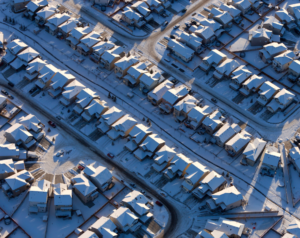Published by Anchorage Daily News on 1.15.25

By Connie Yoshimura
Anchorage’s need for more housing can never be more apparent than now. Today, there are only 200 single-family homes for sale: 101 condos and 55 multi-family for a total of 356 housing units for a population of 286,000. The new construction stats are just as alarming with only 143 single-family homes built along with 27 duplexes, 6 tri-plexes, and 4 four-plexs built in 2024. It’s not that the Anchorage Assembly hasn’t tried to create new opportunities for residential development.
The year 2024 brought some specific and important housing and land use changes. The most important and controversial one was the rezoning of all R1 land and lots to R2 which allowed for an additional housing unit on all single-family platted lots unless prohibited by ‘actively’ enforced covenants, codes, and restrictions either by an HOA or superior court action. Charles Wohlforth, a former assembly member and now a non-resident spoke out against the rezone, claiming that ‘past racism isn’t a reason to change Anchorage zoning laws. His comment was responded to by the president and CEO of the Alaska Black Caucus “What most of us don’t realize is that some plats in the oldest parts of the city have racist covenants. In fact, nearly every neighborhood north of Tudor Road had racist covenants”.
The idea of allowing a duplex in a single-family community does address economic segregation by allowing for a more diverse community and allowing for younger and older residents and can be well integrated with landscaping and exterior architectural creative covenants and HOA control.
Other examples of Housing and Land Use changes passed by the assembly in 2024 include reclassifying four units or fewer as residential rather than commercial construction which eliminates the more expensive set of construction standards. This change makes sense since 4-plexes qualify for residential financing.
Parking requirements have all but been eliminated and left to the residential developer to decide how many spaces his residential units should have. Previously based on the number of bedrooms per unit, let’s just say that off-street parking and a few extra steps for visitors is a smart move if it can create more housing units.
Multi-family development also saw a reduction in extra private space requirements which amount to half the amount of ‘private open space’ previously required. Common open space is really a past-tense idea. What every townhouse-style owner wants is a fenced backyard the width of their unit for children and pets to enjoy and a private deck.
These housing and land use ordinances passed by the Assembly in 2024 are all excellent steps but I doubt they are enough to create 1,000 housing units per year for the next ten years. That’s because two outstanding issues will prevent more housing. The first is the lack of land. The MOA has 1,961 square miles compared to the Mat-Su Valley’s 24,608. I am not the only developer who has looked for and been unable to find 9-10 acres of residential land for a new home community. That ‘missing middle’ is now home to the Valley, where you can purchase a new ranch on a half-acre for under $500,000 or a move-up home with 2400 square feet and a triple car garage for $600,000- $675,000 depending on whether it has an RV bay.
The lack of land and offsite infrastructure in Anchorage for roads, water, and sewer needs to be addressed and improved to have more housing of all types and configurations. Along with that comes financing. The market is getting used to the 6-7% mortgage rate. That’s not what I’m concerned about. But, rather, the fact that acquisition, development, and building are the riskiest of all commercial loans and thus have the higher rate of interest. If you look closely at a commercial lender, he/she would probably acknowledge they would rather lend for a restaurant, French or sushi, or fast food before a land development loan where the payday usually comes when the last vertical lot and/or building is sold.
The housing and land use steps taken in 2024 were bold and should be applauded. We can see how much they move the needle in 2025 for new homes which is the only way to create more rooftops. The next step is finding, creating, and selling more MOA land and creative avenues of financing.

 Connie Yoshimura is the Owner and Broker of Berkshire Hathaway HomeServices Alaska Realty. With over 40 years of residential real estate experience, she continues to be a leader in Alaska’s housing market. Most recently, she sold the highest-priced home ever recorded in the Alaska MLS.
Connie Yoshimura is the Owner and Broker of Berkshire Hathaway HomeServices Alaska Realty. With over 40 years of residential real estate experience, she continues to be a leader in Alaska’s housing market. Most recently, she sold the highest-priced home ever recorded in the Alaska MLS.
Leave a Reply